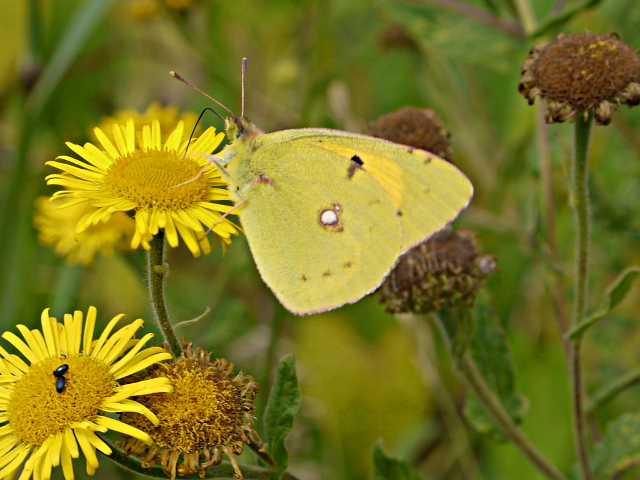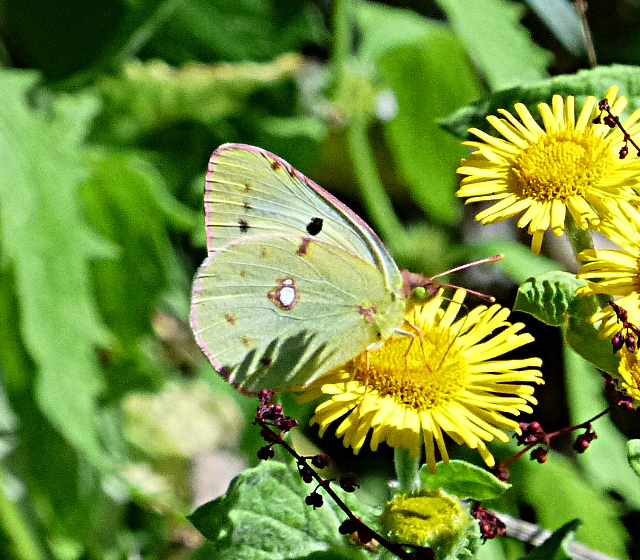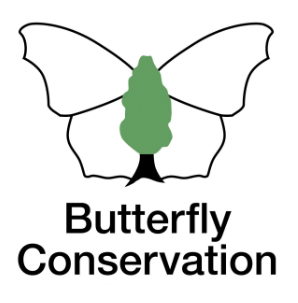Brown Argus
Brown Hairstreak
Chalkhill Blue
Clouded Yellow
Comma
Common Blue
Dark Green Fritillary
Dingy Skipper
Essex Skipper
Gatekeeper
Green Hairstreak
Green-veined White
Grizzled Skipper
Holly Blue
Large Skipper
Large White
Marbled White
Meadow Brown
Orange-tip
Painted Lady
Peacock
Purple Emperor
Purple Hairstreak
Red Admiral
Ringlet
Silver-washed Fritillary
Small Blue
Small Copper
Small Heath
Small Skipper
Small Tortoiseshell
Small White
Speckled Wood
Wall
White Admiral
White-letter Hairstreak
Extinct/rare immigrants
Clouded Yellow
Colias croceus
General Distribution and Status
The Clouded Yellow is an immigrant but numbers arriving each year vary enormously. The majority are seen along or near the south coast but in good years it breeds and disperses further north. In the past few years, there is some evidence that some individuals overwinter successfully as larvae or pupae in the extreme south but most perish and die in the cold (Asher et al.). In the so-called Clouded Yellow years like 1947, when about 36,000 were recorded (Thomas & Lewington), it will be seen in most of England and Wales and some specimens reaching Scotland. Perhaps partly because of climate change there has been a series of good years since the 1970s (1983, 1992, 1994, 1996, 2000 and 2009). As a result, there are proportionately more reports of the species in Hertfordshire and Middlesex.
| United Kingdom | Herts & Middx | |||
| Distribution | 1976-2019 | -67% | 1980-2015 | +5% |
| Average 10-year trend | -33% | 2006-2015 | +21% | |
| 2024 since 2015-19 | -75% | |||
| Abundance | 1976-2024 | +341% | 1980-2015 | -63% |
| 2015-2024 | -79% | 2006-2015 | -70% | |
| 2023-2024 | -80% | 2024 since 2015-19 | 0% | |
UK distribution map
UKBMS Species summary
Habitat Requirements
Almost anywhere where there is an abundance of nectar sources. Clover fields are one of its favourite habitats.
Larval Foodplants
Red Clover Trifolium pratense, White Clover Trifolium repens, Clover spp. Trifolium spp. Lucerne Medicago sativa is mentioned in Sawford's book. Other possible foodplants include Bird's-foot Trefoil Lotus corniculatus and Goat's Rue Galega officinalis (Wood, 2016).
Adult Food Sources
Dandelion Taraxacum spp. (10), Buddleia Buddleja davidii (9), Common Knapweed Centaurea nigra (8), Spear Thistle Cirsium vulgare (5).
Historical Records
There was a profusion of this butterfly at Knebworth in 1900 with many of the helice form according to Gibbs' report. Referring to Foster's report in 1934, he notes the best years as being in 1875, 1877, 1892, 1900, 1922 and 1928. Foster also refers to it as 'abundant even in streets of towns' in 1900. Quite a few reports from the 1940s especially in 1947 when Fryer's report describes it as a 'remarkable year - probably best year for Clouded Yellows since 1877 - pale varieties helice and pallida were not uncommon'. Some experts believed the variety pallida reported in that year was actually the Pale Clouded Yellow. There were no Clouded Yellow years between that year and 1983. Although the cool summers of the 1950s and 1960s may be a factor no significant invasion occurred in the hot summer of 1976.
Local Distribution and Abundance
Only 41 reports of the Clouded Yellow were submitted since 1995 with most records from the Knebworth Park area. Great Ashby Park and Frogmore Gravel Pit attracted some individuals in the 2000s but no reports from these sites since then. Four sightings were reported in 2022, including one in the field south of Watery Grove on 29 October, the latest ever in the Stevenage area but no reports came in for 2023 and 2024. Uncultivated fields where there are plenty of flowers will appeal to the butterfly so areas like the surrounds of Walkern, for example, will be worth searching for in late summer.

Stevenage (South Fairlands Valley Park) transect 1993-2024
Only one sighting of the Clouded Yellow was recorded on my transect: 25 August 2000 in the area now called Millennium Wood where saplings, of mostly oak, were planted during the previous winter.Knebworth Park transect 1996-2010 and 2017-2024
Three Clouded Yellows have been recorded in this transect: 4 September 2000, 24 July 2004 and 6 August 2006.Life History
Earliest date: 21 June 1998 at Norton Green Common
Latest date: 29 October 2022 near Watery Grove
A few specimens visit Britain in the early summer in most years but most are recorded from August, the offspring of the early arrivals augmented by more
immigrants from Europe. The phenology and abundance charts represent all reports in the TL22 decad since 1995 rather than just for transects as transect
counts are far too low. The October record could be of a small second brood. As noted above, very few individuals survive our winter and none have been
reported from Hertfordshire. Eggs are laid singly on the leaves of the foodplant and hatch in about a week. Larvae spend about a month depending upon
temperatures before forming pupae attached to the foodplant.
Behaviour/Observation notes
Its quick flight and usual reluctance to settle long on a flower can make it difficult to get close and take a decent close-up photograph. Males are normally more active so seeking out females egg-laying in clover fields may present better opportunities.
Variations/Aberrations
The well-known form helice, with the inside of its forewings white instead of yellow, is thought to be found in 5-10% of females. It could be
confused with either the Pale Clouded Yellow or Berger's Clouded Yellow but the wider dark borders on the forewings are diagnostic of the Clouded Yellow.
Find out more on the UK Butterflies website
References

Thorley Wash 12 Aug 2013

helice Bookham Commons 23 Aug 2016 (f)





